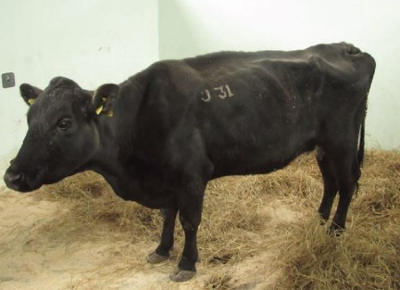By Michelle Arnold
What is Johne’s Disease? Johne’s (pronounced Yo-knees) Disease is a chronic disease of profuse, watery diarrhea and weight loss or “wasting” in adult cattle (Figure 1) caused by the bacterium Mycobacterium avium subsp. paratuberculosis, commonly referred to as “MAP”. This is a slow, progressive disease that begins when calves (not adult cattle) are infected with the MAP bacteria, most often around the time of birth but infection can occur up to 6 months of age and very rarely after. Once MAP gains entry into a calf, the organism lives permanently within the cells of the large intestine where it multiplies and causes the intestinal lining to slowly thicken. With time, the thickened intestine loses the ability to absorb nutrients, resulting in watery diarrhea. There is no blood or mucus in the feces and no straining. The clinical signs of diarrhea and extreme weight loss in spite of having a good appetite, do not show up until 2-5 years of age or even older. There is no treatment available and the animal eventually dies due to starvation and dehydration. The MAP organism is “shed” in the feces before diarrhea starts and continues until the animal’s death. MAP bacteria are very hardy due to a protective cell wall that allows survival for long periods (potentially years) in the environment.

Figure 1: Recently calved cow with signs of Johne’s disease; dull hair coat, profuse watery diarrhea and weight loss.
How do calves get infected with MAP bacteria? Johne’s infection is mainly caused by calves ingesting MAP-contaminated feces from nursing dirty teats. In beef cattle, this is possible in high traffic areas (around hay rings, feeding areas) when mud and manure are splashed on the udder, when calving cows in dirty sheds or barns, or when cattle are held in close confinement. MAP is also shed in colostrum and milk of infected cattle. There is great opportunity for transmission thru colostrum and milk in beef calves since they remain with dams 6-7 months or more and calves steal milk from other cows, too. There can be some spread from an infected cow to her fetus during pregnancy but this is infrequent. Transmission by bulls from semen has never been proven but infected bulls still contaminate the environment with their MAP-infected feces.
How did Johne’s Disease get on my farm? In almost all cases, the MAP bacteria arrived when an infected animal was purchased and added to the herd. The bacteria can be hiding in replacement heifers, cows, breeding bulls, recipients used for embryo transfer, or even in an infected calf grafted on a cow. As cow/calf producers, it is easy to buy (and sell) infected, young breeding age animals with no obvious symptoms even though they are already incubating the disease. The problem is difficult to detect early in subclinical cattle (subclinical=before diarrhea and weight loss develop) but these infected animals can and often do shed high numbers of the MAP organism, contaminating the farm long before there is evidence of a problem. Colostrum from other herds, especially from dairies, is another potential source.